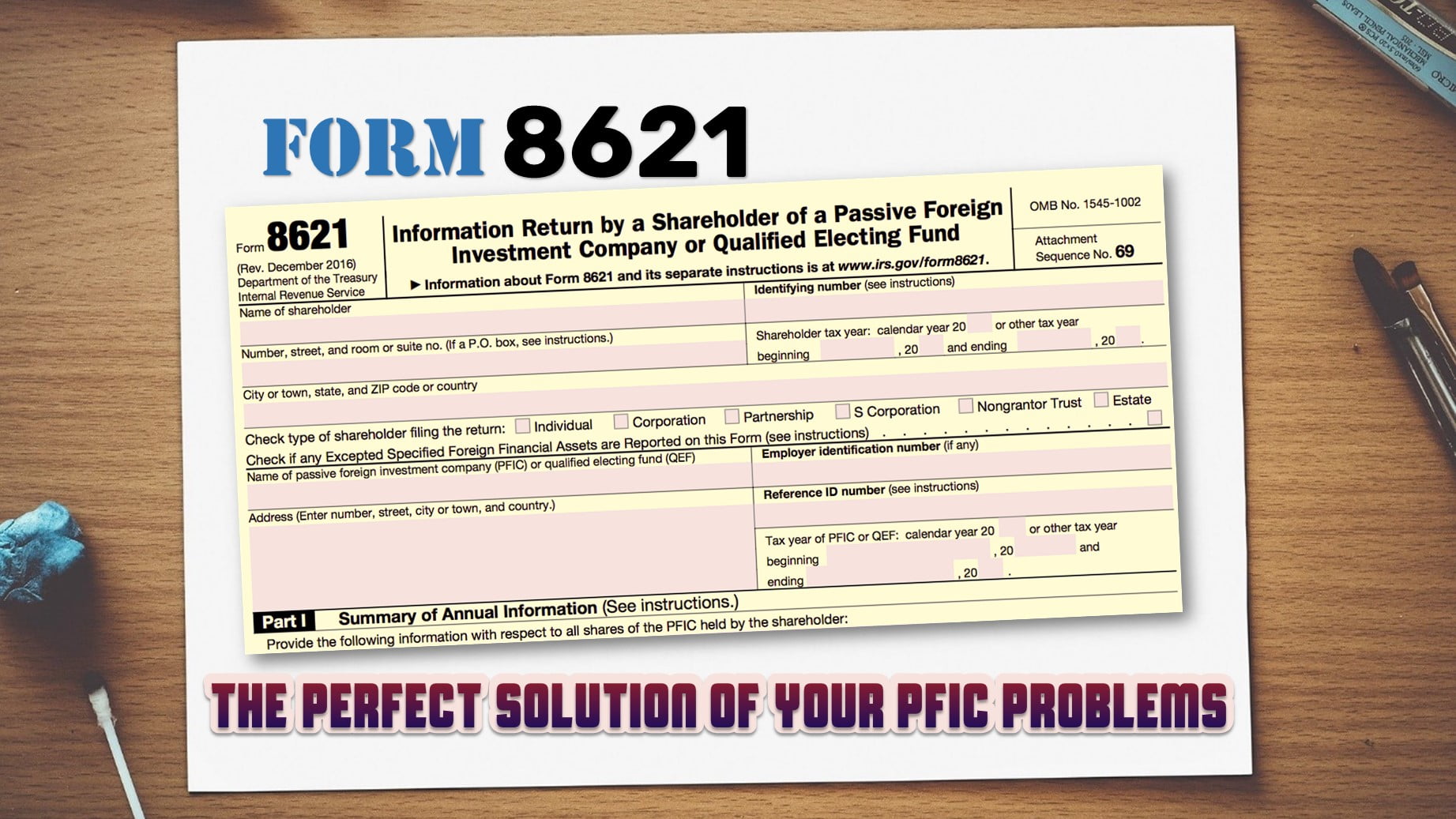
When taxpayers earn passive income from foreign investments, they often have to file Form 8621. This is the main tool for reporting earnings from PFIC companies where the taxpayer is not actively involved. Unfortunately, due to the extremely complex process surrounding excess distributions, the endeavor can quickly turn into a nightmare. Hence why attention to detail and a careful approach are necessary to avoid pricey penalties.
Since passive income is amongst the best ways to accumulate wealth, it is unsurprising that countless taxpayers rely on it. For those unfamiliar, it represents any cash inflow where the investor is not actively involved. Common examples include earnings from rental properties, limited partnerships, or sales of securities. Since a lot of U.S.-based opportunities are quite competitive and risky, however, many people venture out to foreign markets. This is where the Passive Foreign Investment Company (PFIC) rules come in.
PFIC Test and Form 8621
As with all international holdings, U.S. citizens and permanent residents have to report them to the IRS. For PFIC income, reporting happens through Form 8621. The four-page form is an “informational” return that has six parts. While there are quite a few boxes where dollar figures go, taxpayers also need to make appropriate elections. There is also a highly convoluted set of rules that give rise to excess distributions.
PFIC Test
– Income PFIC Test
Before you begin researching the ins and outs of tax requirements, you must look into the initial PFIC test. In reality, there are two ways to determine if your earnings will fall under the PFIC reporting conditions. The first one is to look at the income threshold. In paragraph b of section 1297 of the IRC code, the rules classify any foreign company with 75 percent or more passive income as a PFIC. Thus, if a foreign business has $100,000 in gross earnings and $80,000 are passive, shareholders need to obey PFIC reporting guidelines. That means that the PFIC form and applicable elections immediately come into play.
– Asset PFIC Test
Under paragraph (e) of the same section of the IRC code, you also need to look at the foreign business’ average assets. Namely, if they use 50 percent or more of them to generate passive income, they become a PFIC. The fact that they might come short on the income test is irrelevant because they satisfy the asset test.
Just Because You Have PFIC Ties Does Not Mean You Must File
As of 2014, the PFIC form, which is the Form 8621, has specific thresholds that alleviate tax for small investors. The IRS decided to only assess tax on filers who earn $25,000 or more in PFIC income, when single. That thresholds doubles for married investors filing jointly and they only have to report if they are over $50,000. So, if you and your spouse accumulated $47,500 from passive foreign investments, PFIC reporting rules do not apply. Notice that the government looks at the cumulative number to determine whether you should file Form 8621. That means that it does not matter how small your individual investments may be. Instead, you must stay under the threshold after you add all of them together.
The Subtle Art of Filing the PFIC form
Courtesy of the never-ending lines and a 14-page instruction sheet, Form 8621 is amongst the most challenging ones for foreign income. Fortunately, you can break down the process into a few steps that minimize the odds of improper filing.
1. Find a DoT/IRS Exchange Rate and Convert All Amounts
Before you can sum up all of your PFIC income, there is a good chance that you will have to convert the amounts to dollars. After all, given the “foreign” nature of these earnings, it is reasonable to expect foreign currencies. Since the IRS does not accept anything other than the American Dollar, you will have to recalculate. The best way to find an acceptable rate is to use the Department of Treasury (DoT) or IRS rates. These are posted on the DoT and IRS websites, respectively.
Once you find the rates, simply multiply your PFIC earnings by the exchange factors. Doing so will translate all of the reportable income into U.S. dollars and let you start adding them up. Therefore, the next step is to put them all together and see what the total of your PFIC income is. If you are above the threshold, you need to file Form 8621.
2. Gather the Information
Whilst the IRS mostly cares about the numbers, you still need to report a fair amount of basic information. Most of it goes on the very first page of the PFIC form where you disclose your name, address, and similar. Generally speaking, getting through the informational lines of any Form 8621 is the easy part. Things get a bit more complicated once you enter “Part I” that contains “Summary of Annual Information.” This is where you must describe each class of shares that you own, date and value them, and report excess distribution.
3. Prepare for the Thorn of PFIC Reporting – Excess Distributions
Although everything so far seems quite effortless, it is time to introduce the nemesis of smooth filing – excess distribution. The reason why its reputation is so negative stems from two reasons. First, it is undoubtedly one of the most difficult things to report when it comes to any forms for foreign income. Second, it is amongst the few incredibly unfair IRS demands that put the taxpayer at an enormous disadvantage.
What Exactly Are Excess Distributions for PFIC Reporting?
To understand what excess distributions are and how they tie to the PFIC form, you have to take a step back. The reason why is because you have to understand how the U.S. financial system views passive gains. As per the IRS, passive gains do not happen overnight. Instead, they grow over time and gradually increase in value. The fact that they are continuously growing is what allows the IRS to tax people on a regular basis.
– Foreign Versus Domestic Views of Passive Income
With PFIC investments, that is often not the case. Other countries do not expect passive income to follow a slow, upward-moving curve where there are predictable gains. This is why someone can go overseas and obtain massive gains relatively fast. Once they bring those gains to the U.S., however, the IRS will immediately want to tax them for previous years. For instance, if your foreign investment yields nothing but $23,000 in passive earnings in year six, you will have an excess distribution. Even though you are under the $25,000 threshold, the IRS does not accept that your investment suddenly spiked so much in just one year. They will determine that the $23,000 in passive income was slowly growing in prior years. So, you need to pay tax on those prior years as there was some “unreported” passive growth.
Paying for the Previous Years
Since the hypothetical scenario from the above states that $23,000 is an excess distribution, it is time to do some math. The rule for determining the tax liability uses the 125 percent of the average yield for the past three years. That means that your current distribution cannot be more than 125 percent of the three-year average. Because that $23,000 came out of nowhere, however, all of it is an excess distribution. Why? Well, year three, four, and five had no passive income. That means that 125 percent of the three-year average was zero. Now, you abruptly have $23,000 more than that zero that the IRS expected to see.
The “What-If” Math
The IRS will want you to figure out how much of the $23,000 is attributed to each year that you had the asset. Since the scenario said that you are in year six, you will have a total of 2,191 holding days. Simply divide the $23,000 by 2,191 and you will see that the IRS finds how your passive income was roughly $10.5 per day. That means that you had an average of $3,831 in foreign passive income per year ($10.5 times 365) that you “failed” to report. To penalize you for not reporting that $3,831, you will need to pay the highest ordinary tax rate on it. In 2018, that rate was 37 percent which brings your PFIC tax liability for 2018 alone to over $1,417. Now, repeat the same process for all of the other five years. If that is not convoluted enough, remember that the IRS is going to demand interest and penalty fees as well. Safe to say that finding an accountant for this part of PFIC reporting would be the best course of action.
Failing to File
Failing to adhere to the PFIC reporting guidelines and not filing Form 8621 can be extremely expensive. A common misconception is that taxpayers with small PFIC amounts will not be penalized as much. The dollar figures that you are reporting are completely irrelevant if you are above $25,000 or have excess distributions. The reason why is that they immediately mandate you to file Form 8621. If you do not do so, your entire tax return is “incomplete” because you are missing a vital form.
As far as the IRS goes, there is probably nothing worse than filing incomplete forms. Doing so will expose you to a $10,000 penalty and unlimited audits on your Form 8621 that could last forever. In other words, there is no statute of limitations like violations of some other forms carry. Not to mention that failing to report excess distributions on a PFIC form opens you up to criminal investigations.
– Better Safe Than Sorry
If you are unsure about the PFIC test, PFIC reporting, or the PFIC form in general, filing may be the best choice. After all, filing when you should not is incomparably better than not filing when you should have.
The information is not intended to constitute professional advice and may not be appropriate for a specific individual or fact situation. It is written by the author solely in their personal capacity and cannot be attributed to the accounting firm with which they are affiliated. It is not intended to constitute professional advice, and neither the author nor the firm with which the author is associated shall accept any liability in respect of any reliance on the information contained herein. Readers should always consult with their professional advisors in respect of their particular situations.

